service indicator CADILLAC ESCALADE EXT 2008 3.G User Guide
[x] Cancel search | Manufacturer: CADILLAC, Model Year: 2008, Model line: ESCALADE EXT, Model: CADILLAC ESCALADE EXT 2008 3.GPages: 496, PDF Size: 7.02 MB
Page 366 of 496
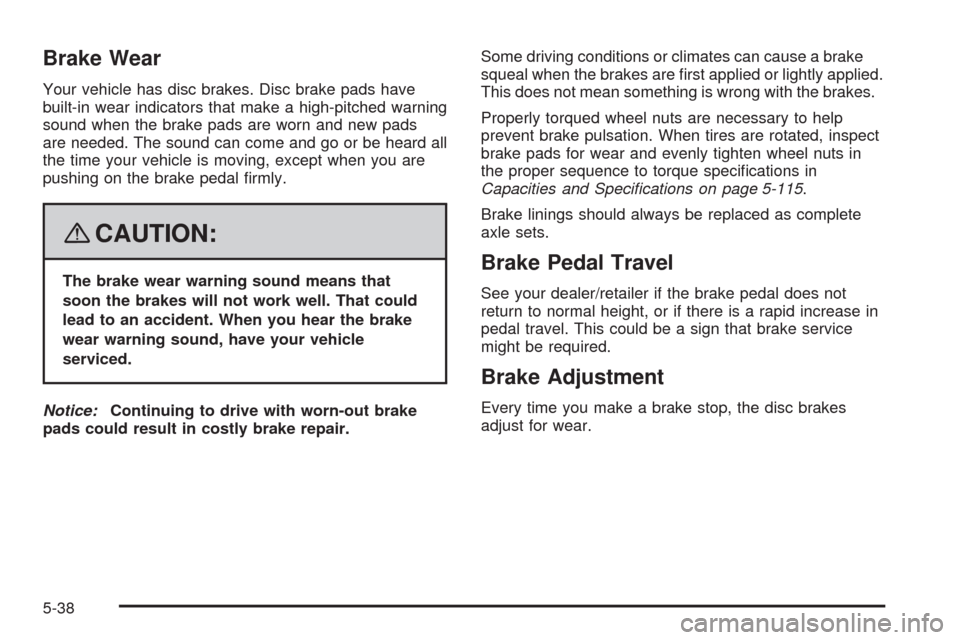
Brake Wear
Your vehicle has disc brakes. Disc brake pads have
built-in wear indicators that make a high-pitched warning
sound when the brake pads are worn and new pads
are needed. The sound can come and go or be heard all
the time your vehicle is moving, except when you are
pushing on the brake pedal �rmly.
{CAUTION:
The brake wear warning sound means that
soon the brakes will not work well. That could
lead to an accident. When you hear the brake
wear warning sound, have your vehicle
serviced.
Notice:Continuing to drive with worn-out brake
pads could result in costly brake repair.Some driving conditions or climates can cause a brake
squeal when the brakes are �rst applied or lightly applied.
This does not mean something is wrong with the brakes.
Properly torqued wheel nuts are necessary to help
prevent brake pulsation. When tires are rotated, inspect
brake pads for wear and evenly tighten wheel nuts in
the proper sequence to torque speci�cations in
Capacities and Speci�cations on page 5-115.
Brake linings should always be replaced as complete
axle sets.Brake Pedal Travel
See your dealer/retailer if the brake pedal does not
return to normal height, or if there is a rapid increase in
pedal travel. This could be a sign that brake service
might be required.
Brake Adjustment
Every time you make a brake stop, the disc brakes
adjust for wear.
5-38
Page 392 of 496

When the malfunction indicator is illuminated, the
system may not be able to detect or signal low tire
pressure as intended. TPMS malfunctions may occur
for a variety of reasons, including the installation
of replacement or alternate tires or wheels on the
vehicle that prevent the TPMS from functioning properly.
Always check the TPMS malfunction telltale after
replacing one or more tires or wheels on your vehicle
to ensure that the replacement or alternate tires
and wheels allow the TPMS to continue to function
properly.
SeeTire Pressure Monitor Operation on page 5-64,
for additional information.
Federal Communications
Commission (FCC) and Industry
and Science Canada
The Tire Pressure Monitor System (TPMS) operates
on a radio frequency and complies with Part 15 of
the FCC Rules. Operation is subject to the following
two conditions:
1. This device may not cause harmful interference.
2. This device must accept any interference received,
including interference that may cause undesired
operation.The Tire Pressure Monitor System (TPMS) operates
on a radio frequency and complies with RSS-210
of Industry and Science Canada. Operation is subject
to the following two conditions:
1. This device may not cause interference.
2. This device must accept any interference received,
including interference that may cause undesired
operation of the device.
Changes or modi�cations to this system by other than
an authorized service facility could void authorization to
use this equipment.
Tire Pressure Monitor Operation
The Tire Pressure Monitor System (TPMS) is designed
to warn the driver when a low tire pressure condition
exists. TPMS sensors are mounted onto each tire
and wheel assembly, excluding the spare tire and wheel
assembly. The TPMS sensors monitor the air pressure
in the vehicle’s tires and transmits the tire pressure
readings to a receiver located in the vehicle.
5-64
Page 449 of 496
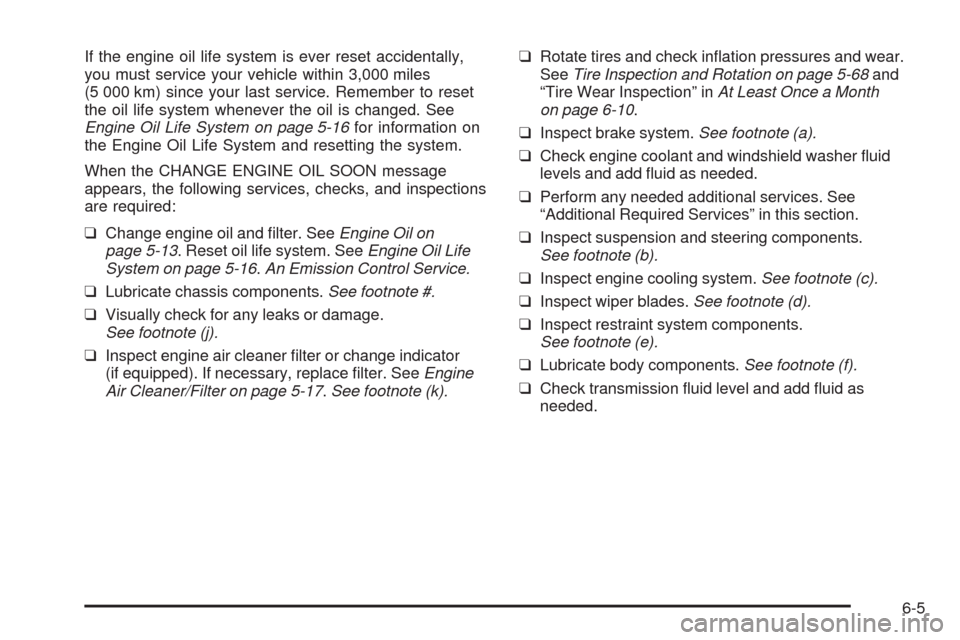
If the engine oil life system is ever reset accidentally,
you must service your vehicle within 3,000 miles
(5 000 km) since your last service. Remember to reset
the oil life system whenever the oil is changed. See
Engine Oil Life System on page 5-16for information on
the Engine Oil Life System and resetting the system.
When the CHANGE ENGINE OIL SOON message
appears, the following services, checks, and inspections
are required:
❑Change engine oil and �lter. SeeEngine Oil on
page 5-13. Reset oil life system. SeeEngine Oil Life
System on page 5-16.An Emission Control Service.
❑Lubricate chassis components.See footnote #.
❑Visually check for any leaks or damage.
See footnote (j).
❑Inspect engine air cleaner �lter or change indicator
(if equipped). If necessary, replace �lter. SeeEngine
Air Cleaner/Filter on page 5-17.See footnote (k).❑Rotate tires and check in�ation pressures and wear.
SeeTire Inspection and Rotation on page 5-68and
“Tire Wear Inspection” inAt Least Once a Month
on page 6-10.
❑Inspect brake system.See footnote (a).
❑Check engine coolant and windshield washer �uid
levels and add �uid as needed.
❑Perform any needed additional services. See
“Additional Required Services” in this section.
❑Inspect suspension and steering components.
See footnote (b).
❑Inspect engine cooling system.See footnote (c).
❑Inspect wiper blades.See footnote (d).
❑Inspect restraint system components.
See footnote (e).
❑Lubricate body components.See footnote (f).
❑Check transmission �uid level and add �uid as
needed.
6-5
Page 450 of 496
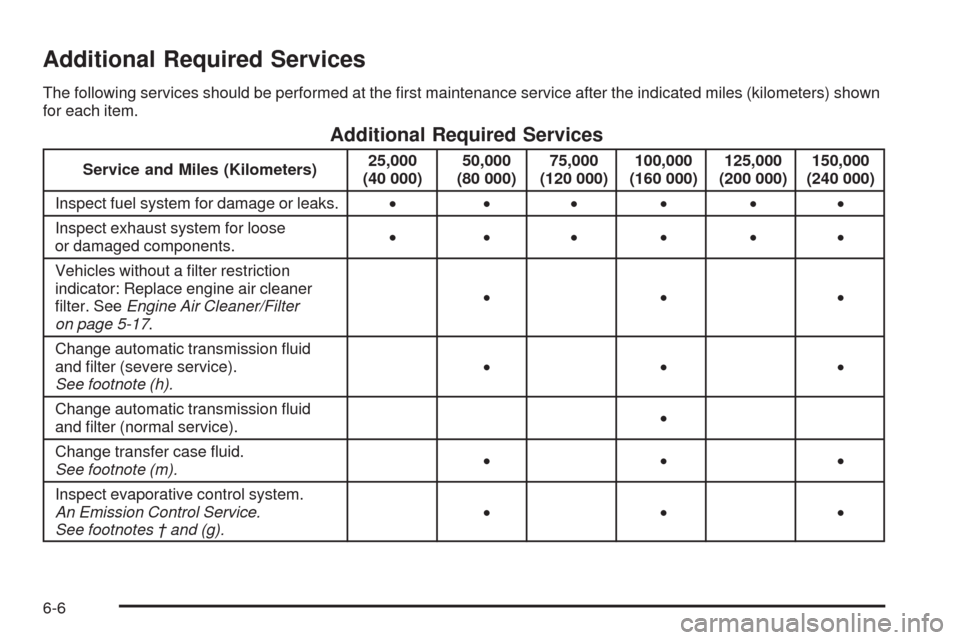
Additional Required Services
The following services should be performed at the �rst maintenance service after the indicated miles (kilometers) shown
for each item.
Additional Required Services
Service and Miles (Kilometers)25,000
(40 000)50,000
(80 000)75,000
(120 000)100,000
(160 000)125,000
(200 000)150,000
(240 000)
Inspect fuel system for damage or leaks.• •••••
Inspect exhaust system for loose
or damaged components.• •••••
Vehicles without a �lter restriction
indicator: Replace engine air cleaner
�lter. SeeEngine Air Cleaner/Filter
on page 5-17.•••
Change automatic transmission �uid
and �lter (severe service).
See footnote (h).•••
Change automatic transmission �uid
and �lter (normal service).•
Change transfer case �uid.
See footnote (m).•••
Inspect evaporative control system.
An Emission Control Service.
See footnotes † and (g).•••
6-6
Page 483 of 496
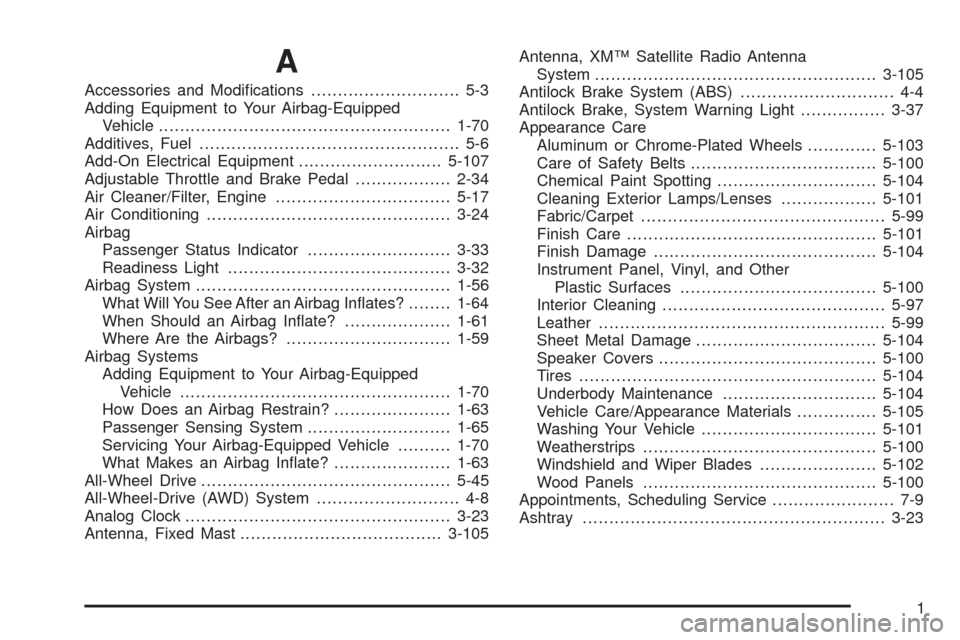
A
Accessories and Modi�cations............................ 5-3
Adding Equipment to Your Airbag-Equipped
Vehicle.......................................................1-70
Additives, Fuel................................................. 5-6
Add-On Electrical Equipment...........................5-107
Adjustable Throttle and Brake Pedal..................2-34
Air Cleaner/Filter, Engine.................................5-17
Air Conditioning..............................................3-24
Airbag
Passenger Status Indicator...........................3-33
Readiness Light..........................................3-32
Airbag System................................................1-56
What Will You See After an Airbag In�ates?........1-64
When Should an Airbag In�ate?....................1-61
Where Are the Airbags?...............................1-59
Airbag Systems
Adding Equipment to Your Airbag-Equipped
Vehicle...................................................1-70
How Does an Airbag Restrain?......................1-63
Passenger Sensing System...........................1-65
Servicing Your Airbag-Equipped Vehicle..........1-70
What Makes an Airbag In�ate?......................1-63
All-Wheel Drive...............................................5-45
All-Wheel-Drive (AWD) System........................... 4-8
Analog Clock..................................................3-23
Antenna, Fixed Mast......................................3-105Antenna, XM™ Satellite Radio Antenna
System.....................................................3-105
Antilock Brake System (ABS)............................. 4-4
Antilock Brake, System Warning Light................3-37
Appearance Care
Aluminum or Chrome-Plated Wheels.............5-103
Care of Safety Belts...................................5-100
Chemical Paint Spotting..............................5-104
Cleaning Exterior Lamps/Lenses..................5-101
Fabric/Carpet..............................................5-99
Finish Care...............................................5-101
Finish Damage..........................................5-104
Instrument Panel, Vinyl, and Other
Plastic Surfaces.....................................
5-100
Interior Cleaning..........................................5-97
Leather......................................................5-99
Sheet Metal Damage..................................5-104
Speaker Covers.........................................5-100
Tires........................................................5-104
Underbody Maintenance.............................5-104
Vehicle Care/Appearance Materials...............5-105
Washing Your Vehicle.................................5-101
Weatherstrips............................................5-100
Windshield and Wiper Blades......................5-102
Wood Panels............................................5-100
Appointments, Scheduling Service....................... 7-9
Ashtray.........................................................3-23
1
Page 490 of 496
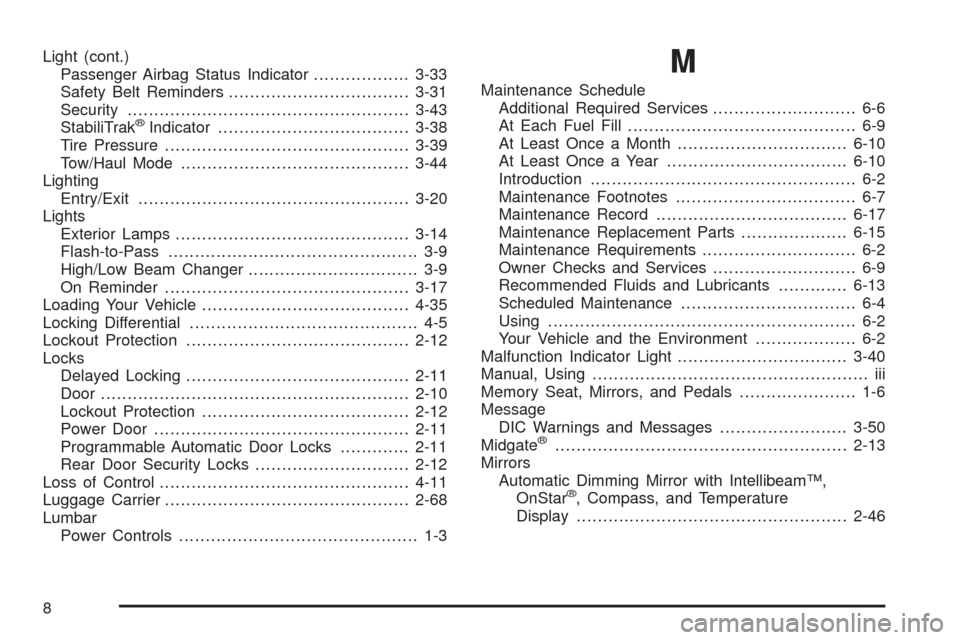
Light (cont.)
Passenger Airbag Status Indicator..................3-33
Safety Belt Reminders..................................3-31
Security.....................................................3-43
StabiliTrak
®Indicator....................................3-38
Tire Pressure..............................................3-39
Tow/Haul Mode...........................................3-44
Lighting
Entry/Exit...................................................3-20
Lights
Exterior Lamps............................................3-14
Flash-to-Pass............................................... 3-9
High/Low Beam Changer................................ 3-9
On Reminder..............................................3-17
Loading Your Vehicle.......................................4-35
Locking Differential........................................... 4-5
Lockout Protection..........................................2-12
Locks
Delayed Locking..........................................2-11
Door..........................................................2-10
Lockout Protection.......................................2-12
Power Door................................................2-11
Programmable Automatic Door Locks.............2-11
Rear Door Security Locks.............................2-12
Loss of Control...............................................4-11
Luggage Carrier..............................................2-68
Lumbar
Power Controls............................................. 1-3
M
Maintenance Schedule
Additional Required Services........................... 6-6
At Each Fuel Fill........................................... 6-9
At Least Once a Month................................6-10
At Least Once a Year..................................6-10
Introduction.................................................. 6-2
Maintenance Footnotes.................................. 6-7
Maintenance Record....................................6-17
Maintenance Replacement Parts....................6-15
Maintenance Requirements............................. 6-2
Owner Checks and Services........................... 6-9
Recommended Fluids and Lubricants.............6-13
Scheduled Maintenance................................. 6-4
Using.......................................................... 6-2
Your Vehicle and the Environment................... 6-2
Malfunction Indicator Light................................3-40
Manual, Using.................................................... iii
Memory Seat, Mirrors, and Pedals...................... 1-6
Message
DIC Warnings and Messages........................3-50
Midgate
®.......................................................2-13
Mirrors
Automatic Dimming Mirror with Intellibeam™,
OnStar
®, Compass, and Temperature
Display...................................................2-46
8
Page 491 of 496
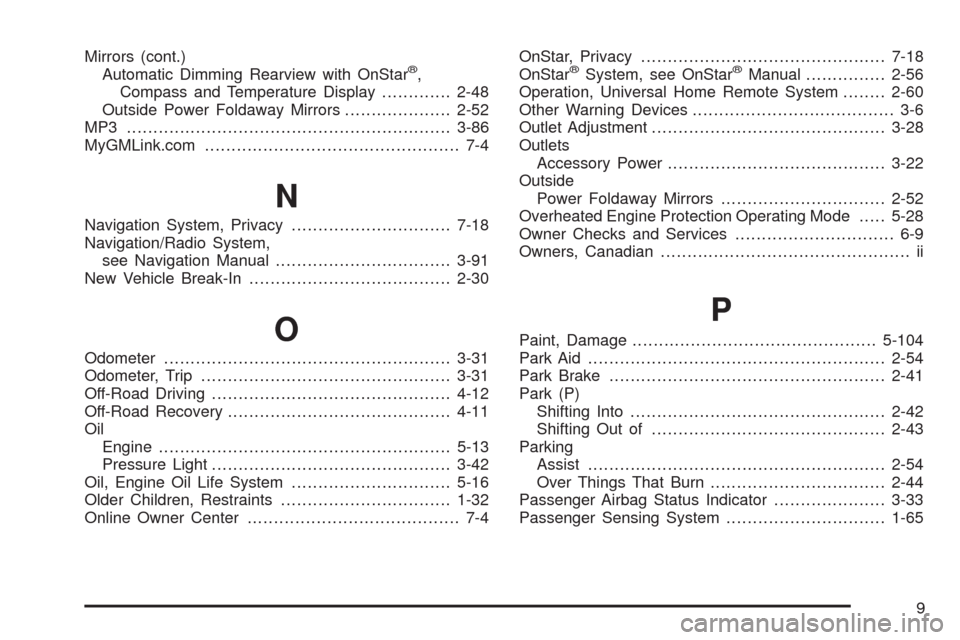
Mirrors (cont.)
Automatic Dimming Rearview with OnStar®,
Compass and Temperature Display.............2-48
Outside Power Foldaway Mirrors....................2-52
MP3 .............................................................3-86
MyGMLink.com................................................ 7-4
N
Navigation System, Privacy..............................7-18
Navigation/Radio System,
see Navigation Manual.................................3-91
New Vehicle Break-In......................................2-30
O
Odometer......................................................3-31
Odometer, Trip...............................................3-31
Off-Road Driving.............................................4-12
Off-Road Recovery..........................................4-11
Oil
Engine.......................................................5-13
Pressure Light.............................................3-42
Oil, Engine Oil Life System..............................5-16
Older Children, Restraints................................1-32
Online Owner Center........................................ 7-4OnStar, Privacy..............................................7-18
OnStar
®System, see OnStar®Manual...............2-56
Operation, Universal Home Remote System........2-60
Other Warning Devices...................................... 3-6
Outlet Adjustment............................................3-28
Outlets
Accessory Power.........................................3-22
Outside
Power Foldaway Mirrors...............................2-52
Overheated Engine Protection Operating Mode.....5-28
Owner Checks and Services.............................. 6-9
Owners, Canadian............................................... ii
P
Paint, Damage..............................................5-104
Park Aid........................................................2-54
Park Brake....................................................2-41
Park (P)
Shifting Into................................................2-42
Shifting Out of............................................2-43
Parking
Assist........................................................2-54
Over Things That Burn.................................2-44
Passenger Airbag Status Indicator.....................3-33
Passenger Sensing System..............................1-65
9
Page 494 of 496
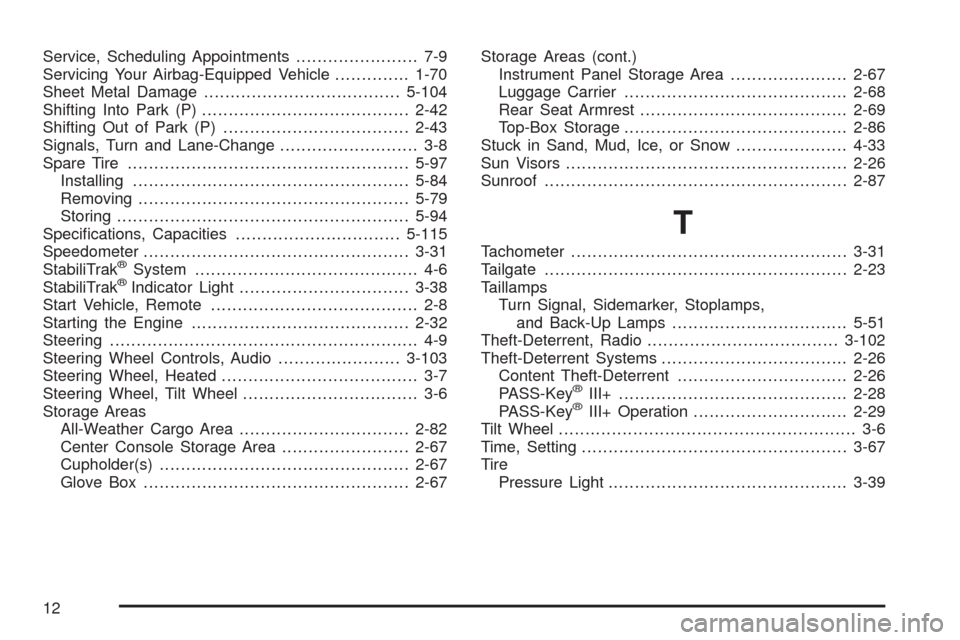
Service, Scheduling Appointments....................... 7-9
Servicing Your Airbag-Equipped Vehicle..............1-70
Sheet Metal Damage.....................................5-104
Shifting Into Park (P).......................................2-42
Shifting Out of Park (P)...................................2-43
Signals, Turn and Lane-Change.......................... 3-8
Spare Tire.....................................................5-97
Installing....................................................5-84
Removing...................................................5-79
Storing.......................................................5-94
Speci�cations, Capacities...............................5-115
Speedometer..................................................3-31
StabiliTrak
®System.......................................... 4-6
StabiliTrak®Indicator Light................................3-38
Start Vehicle, Remote....................................... 2-8
Starting the Engine.........................................2-32
Steering.......................................................... 4-9
Steering Wheel Controls, Audio.......................3-103
Steering Wheel, Heated..................................... 3-7
Steering Wheel, Tilt Wheel................................. 3-6
Storage Areas
All-Weather Cargo Area................................2-82
Center Console Storage Area........................2-67
Cupholder(s)...............................................2-67
Glove Box..................................................2-67Storage Areas (cont.)
Instrument Panel Storage Area......................2-67
Luggage Carrier..........................................2-68
Rear Seat Armrest.......................................2-69
Top-Box Storage..........................................2-86
Stuck in Sand, Mud, Ice, or Snow.....................4-33
Sun Visors.....................................................2-26
Sunroof.........................................................2-87
T
Tachometer....................................................3-31
Tailgate.........................................................2-23
Taillamps
Turn Signal, Sidemarker, Stoplamps,
and Back-Up Lamps.................................5-51
Theft-Deterrent, Radio....................................3-102
Theft-Deterrent Systems...................................2-26
Content Theft-Deterrent................................2-26
PASS-Key
®III+...........................................2-28
PASS-Key®III+ Operation.............................2-29
Tilt Wheel........................................................ 3-6
Time, Setting..................................................3-67
Tire
Pressure Light.............................................3-39
12
Page 496 of 496
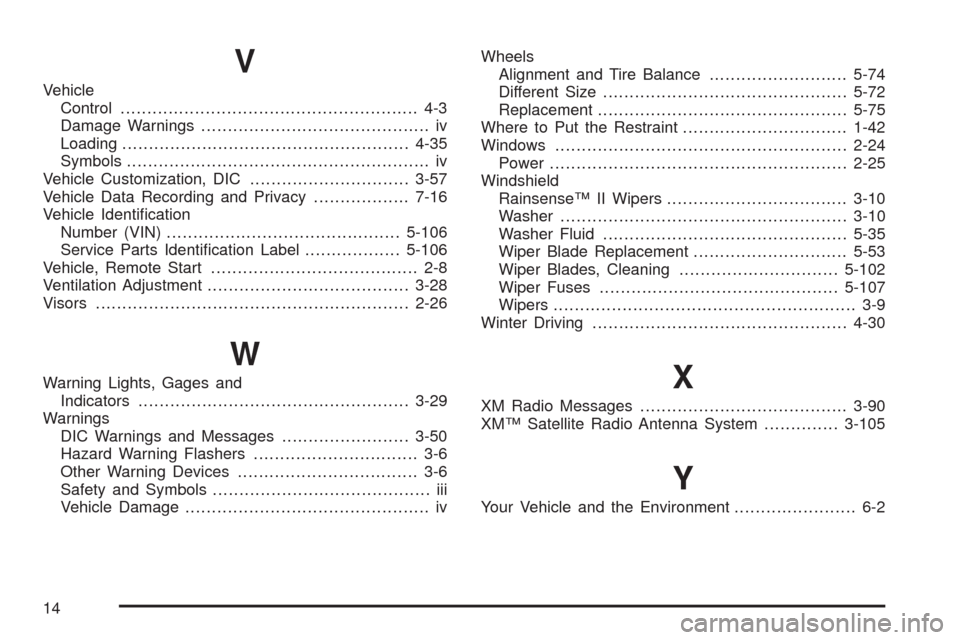
V
Vehicle
Control........................................................ 4-3
Damage Warnings........................................... iv
Loading......................................................4-35
Symbols......................................................... iv
Vehicle Customization, DIC..............................3-57
Vehicle Data Recording and Privacy..................7-16
Vehicle Identi�cation
Number (VIN)............................................5-106
Service Parts Identi�cation Label..................5-106
Vehicle, Remote Start....................................... 2-8
Ventilation Adjustment......................................3-28
Visors...........................................................2-26
W
Warning Lights, Gages and
Indicators...................................................3-29
Warnings
DIC Warnings and Messages........................3-50
Hazard Warning Flashers............................... 3-6
Other Warning Devices.................................. 3-6
Safety and Symbols......................................... iii
Vehicle Damage.............................................. ivWheels
Alignment and Tire Balance..........................5-74
Different Size..............................................5-72
Replacement...............................................5-75
Where to Put the Restraint...............................1-42
Windows.......................................................2-24
Power........................................................2-25
Windshield
Rainsense™ II Wipers..................................3-10
Washer......................................................3-10
Washer Fluid..............................................5-35
Wiper Blade Replacement.............................5-53
Wiper Blades, Cleaning..............................5-102
Wiper Fuses.............................................5-107
Wipers......................................................... 3-9
Winter Driving................................................4-30X
XM Radio Messages.......................................3-90
XM™ Satellite Radio Antenna System..............3-105
Y
Your Vehicle and the Environment....................... 6-2
14